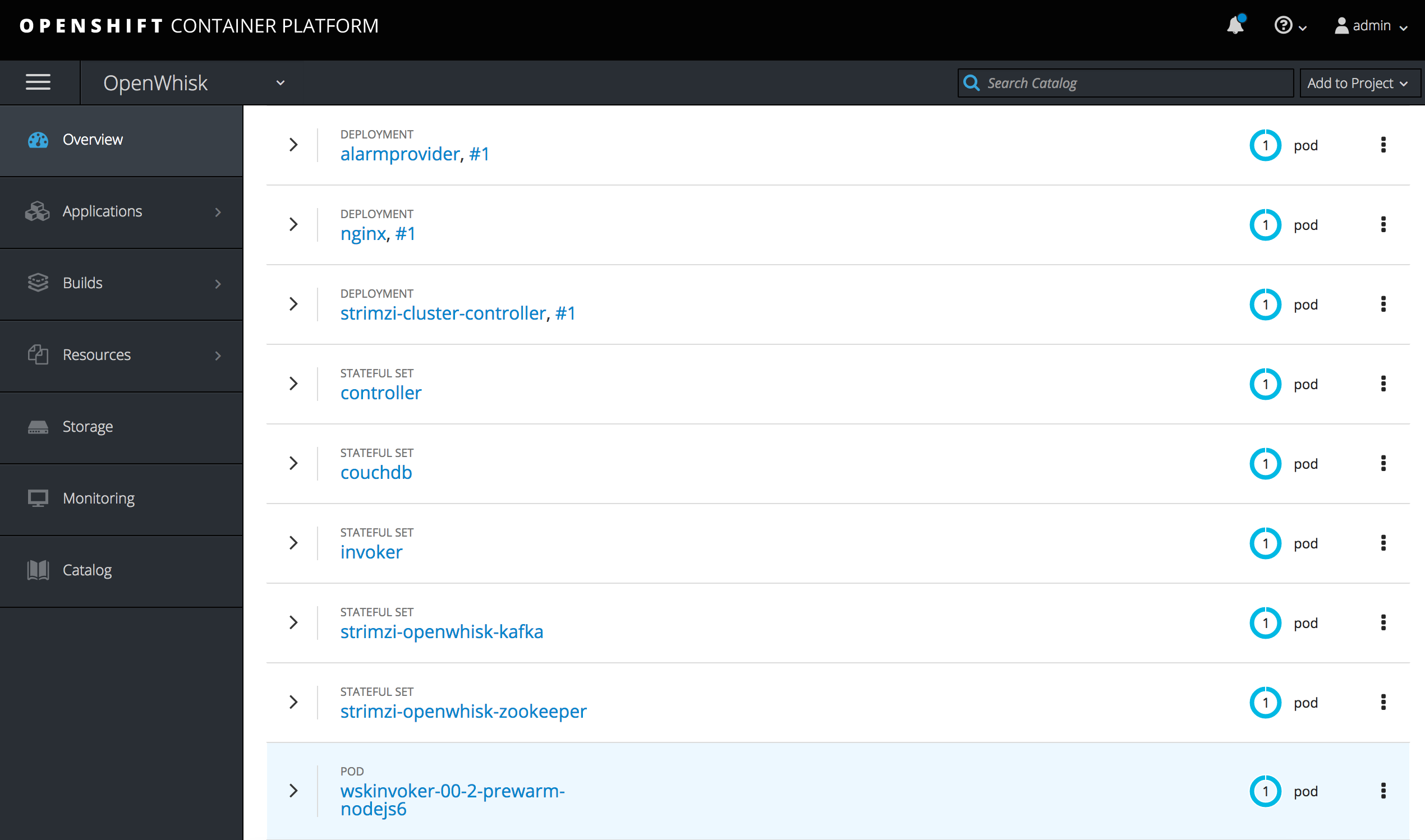OpenWhisk can be deployed using the template provided by OpenWhisk on OpenShift project. Each component of OpenWhisk will be running in its own container.
-
Create a new project in OpenShift called openwhisk:
$ oc new-project openwhisk --display-name="OpenWhisk"
Now using project "openwhisk" on server "https://infranode-<GUID>.generic.opentlc.com:8443".
You can add applications to this project with the 'new-app' command. For example, try:
oc new-app centos/ruby-22-centos7~https://github.com/openshift/ruby-ex.git
to build a new example application in Ruby.-
Deploy OpenWhisk by instantiating the template
$ oc process -f https://raw.githubusercontent.com/projectodd/openwhisk-openshift/master/persistent-template.yml | oc create -f -| A large number of resources will be created. It will take a few minutes to each of the resources to fully deploy to the OpenWhisk project. |
-
Use watch command to monitor the progress:
$ watch oc get podsOnce all pods are in the “Running” or “Completed state”, hit CTRL+C to break the “watch” command.
| Pods may initially report in Error status. This condition should resolve itself in a few moments. |
-
Check the status of deployment:
$ oc get pods
NAME READY STATUS RESTARTS AGE
alarmprovider-76d5655b8-vpp7s 1/1 Running 0 1d
controller-0 1/1 Running 2 1d
couchdb-0 1/1 Running 0 1d
install-catalog-hx8pc 0/1 Completed 0 1d
invoker-0 1/1 Running 0 1d
nginx-c6f755db5-q627l 1/1 Running 0 1d
preload-openwhisk-runtimes-kfxcj 0/1 Completed 0 1d
prune-activations-1525060800-n4drp 0/1 Completed 0 19h
refresh-activations-1525132200-lt4h2 0/1 Completed 0 1m
strimzi-cluster-controller-69dccbcc97-724ht 1/1 Running 0 1d
strimzi-openwhisk-kafka-0 1/1 Running 0 1d
strimzi-openwhisk-zookeeper-0 1/1 Running 0 1d
wskinvoker-00-5-prewarm-nodejs6 1/1 Running 0 18h
wskinvoker-00-6-prewarm-nodejs6 1/1 Running 0 18h-
Verify that system is ready by checking if controller recognizes the invoker as healthy:
$ oc logs -f controller-0 | grep "invoker status changed"
[INFO] [#sid_121] [InvokerPool] invoker status changed to 0 -> UnHealthy
[INFO] [#sid_121] [InvokerPool] invoker status changed to 0 -> HealthyOpenWhisk has been successfully deployed when 0 → Healthy appears in the log above
Verify OpenWhisk Deployment using OpenShift web console
-
Navigate to the following url in the browser:
| OpenShift web UI access url is provided in the screen splash when you ssh into the system |
-
Click on the project name (OpenWhisk) in the upper right corner. A successful deployment will look like the following:

Configure the OpenWhisk CLI
wsk is the CLI to interact with OpenWhisk services which has already been downloaded on this system. The wsk CLI needs to be to be configured to be able to interact with OpenWhisk deployment.
-
Use the following commands to configure wsk:
$ AUTH_SECRET=$(oc get secret whisk.auth -o yaml | grep "system:" | awk '{print $2}' | base64 --decode)
$ wsk property set --auth $AUTH_SECRET --apihost $(oc get route/openwhisk --template="{{.spec.host}}")Successful configuration of wsk will show following output:
ok: whisk auth set. Run 'wsk property get --auth' to see the new value.
ok: whisk API host set to openwhisk-openwhisk.apps-<GUID>.generic.opentlc.com
Use the -i option with wsk to avoid the validation error triggered by the self-signed cert in the nginx service.
|